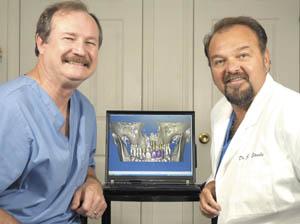High-tech implants
Published 12:00 am Monday, July 30, 2007

- Photo by Lara Cooper/Daily NewsDrs. Phillip VanMeter and Joseph Steele show a CAT scan image of a patient who underwent the procedure.
When Melissa Brockman was younger, she lost her front teeth in a bike accident.
“I had a root canal and bridge,” the Hartsville, Tenn., woman said.
By the time she joined the Army in 2002, she’d had the bridge for a long time. But a few years later, it started coming lose. And two tours of duty to Iraq – one in 2003 and one in 2005 – didn’t make things easier.
“I had some abscessed teeth. I didn’t have time to get my teeth cleaned while I was in and out of Iraq, so it caused some erosion there,” said Brockman, who was an Army administrative specialist. “I was sent to Germany to a periodontist who said I didn’t have enough bone. He put in bone implants. Then I was sent to Iraq and didn’t have time to finish the implants.”
Once she retired from the Army in 2006, Brockman knew she wanted a more permanent solution. She consulted her mother’s Bowling Green dentist, Dr. Joseph Steele, about implants and recently had them done.
“He said he could do it. It didn’t hurt,” she said. “They did a wonderful job. They’re very white and straight. They’re perfect.”
Dental implants are titanium rods that are surgically placed into the jawbone after which prosthetic teeth are fixed to the rods. The process used to take several months between placing the implants and placing the teeth because it required waiting for the implants to integrate with the patient’s bone.
Now with new technology that uses computer-guided implant surgery, a periodontist and prosthodontist can sometimes place the implants and teeth in the same day. The teeth can even be made before the implants.
“A patient can come in with no teeth and walk out with a full set of teeth,” Steele said. “A patient can go to work the next morning with no swelling.”
Steele and Bowling Green periodonitist Dr. Phillip VanMeter have done lots of implants together using the old method, but recently began using the new dental implant technology a couple of months ago. They have used it on two patients and have several more scheduled, VanMeter said. VanMeter handles the surgery and Steele makes the prosthetic teeth.
“(The implants) are coated with a special coating to help them heal better,” VanMeter said. “It’s fixed to the bridge. You can’t just take them out.”
The process begins with a CAT scan at Western Kentucky Diagnostics Imaging. The scan is converted to software that is used to plan the surgery, Steele said. The software – which shows the patient’s scan in 3D – can help the surgeon avoid nerves, teeth and other things that could be harmful for the patient.
“That way, we know exactly where to place the implants,” he said. “We can plan everything without the patient being there.”
Next, a surgical template is ordered from Europe, VanMeter said. The template has rings to direct the special drills used to the right depth and position. Steele uses the template to make a working cast model and to construct the prosthetic teeth. On the day of surgery, the patient receives anesthesia and is awake for the surgery. The drill is used to help place the implant. Cutting and laying back gums is not necessary, making it almost painless.
“I suggest two months on a soft diet (after the surgery for dental implant patients),” Steele said.
Some people are too young to consider dental implant surgery, VanMeter said.
“We want to make sure they have mature bones,” he said.
Insurance doesn’t usually cover dental implants unless there is a situation such as trauma or birth defects, Steele said.
“The cost isn’t that much different than an unguided (dental implant) surgery,” he said.
Brockman said her dental implants were worth every penny.
“It looks natural. I brush and floss regularly. If you’re willing to spend the money, that is the way to go,” she said. “I think it’s better than a bridge. They’re supposed to last you for the rest of your life. It feels tighter, like it’s a part of my real teeth. I can’t tell that it’s not my teeth.”






